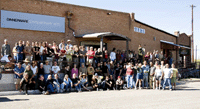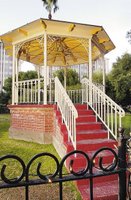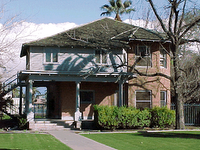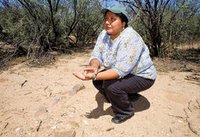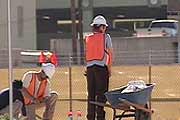 [Source: Suzanne Adams, Kingman Daily Miner] -- Train watchers and fans from near and far are eagerly awaiting the start of renovations on the old Santa Fe Depot in downtown Kingman. "There's so many people interested in trains it's incredible! I've got tons of people with railroad artifacts interested in the project," said Shannon Rossiter of the Mohave Museum of History and Arts. Plans for the renovation of the old train depot are about 95 percent complete, said Rob Owen, special projects coordinator for the city of Kingman. All that needs to be done is to have BNSF Railway and Amtrak give their final approval for the project. Owen hopes to have that approval by January so the project can go out for bid at the end of February. The restoration work can then start in March.
[Source: Suzanne Adams, Kingman Daily Miner] -- Train watchers and fans from near and far are eagerly awaiting the start of renovations on the old Santa Fe Depot in downtown Kingman. "There's so many people interested in trains it's incredible! I've got tons of people with railroad artifacts interested in the project," said Shannon Rossiter of the Mohave Museum of History and Arts. Plans for the renovation of the old train depot are about 95 percent complete, said Rob Owen, special projects coordinator for the city of Kingman. All that needs to be done is to have BNSF Railway and Amtrak give their final approval for the project. Owen hopes to have that approval by January so the project can go out for bid at the end of February. The restoration work can then start in March.The city will be reimbursed for 94.3% of the restoration work by a Federal Transportation Enhancement Grant. The city applied for the $500,000 grant in 2001 and received approval in 2002. The grant is administered by the Arizona Department of Transportation. Kingman will have to match 5.7 percent of the cost of the project. Despite its age, the depot is still structurally sound, Owen said. The old station will be receiving new doors, windows, paint, plumbing and electrical work, heating and air conditioning, stucco and new landscaping as part of the renovation work. Ever since 2002, Kingman residents have been asking when work was going to begin. A lot of people don't understand the grant process, said Bill Shilling, a city grant administrator. It can take many years to apply, receive approval and get funds from a grant for a project. [Note: To read the full article, click here. Photo by JC Amberlyn, Daily Miner.]






